Public Health Scotland (PHS) has announced it is no longer going to publish its Covid infection, hospitalisation and death rates by vaccination status. Purportedly this is because it is being misrepresented by “anti-vaxxers”, according to a report in the Scotsman. But a more likely explanation is because it looks so bad. Here’s the “notice of change” (there are further notices for each section going into more detail).
NOTICE OF CHANGE
From February 16th 2022, Public Health Scotland (PHS) will no longer report COVID-19 cases, hospitalisations, and deaths by vaccination status on a weekly basis. PHS will continue to provide updates from the latest scientific analyses and reports on the effectiveness of COVID-19 vaccines. An explanation behind this decision can be found below.
Since July 2021, Public Health Scotland (PHS) have [sic] reported COVID-19 cases, hospitalisations, and deaths by vaccination status in the weekly COVID-19 statistical report. These data were first published to help monitor the impact of the vaccination programme on the pandemic, impact on the NHS, and to help understand where to prioritise vaccination delivery. While PHS has stated that the data in the report should not be used as a measure of vaccine effectiveness, PHS is aware of inappropriate use and misinterpretation of the data when taken in isolation without fully understanding the limitations described below.
Due to the increasing risk of misinterpretation from growing complexities as the COVID-19 pandemic enters its second year (as described below), PHS has taken the decision to no longer report COVID-19 cases, hospitalisations and deaths by vaccination status on a weekly basis. PHS is currently reviewing the content and frequency of reporting this information. PHS will continue to communicate up to date and high quality research on COVID-19 vaccines. Evidence suggests the COVID-19 vaccine is effective at reducing the risk of a severe outcome, such as hospitalisation when infected, however no vaccine is 100% effective and some COVID-19 hospitalisations and deaths may still occur, particularly in vulnerable populations. PHS, in collaboration with partners such as the EAVE II consortium, will continue supporting comprehensive scientific studies evaluating the risks and reasons for severe COVID-19 in vaccinated populations and will communicate its findings as and when appropriate.
In its piece explaining the change, the Scotsman points the finger at us (well, Toby – but the “promotion on social media” referred to will presumably be his tweets promoting Daily Sceptic posts):
The data has been promoted on social media by individuals including the Spectator’s associate editor Toby Young, the American right-wing opinion website, The Blaze, and anti-vaxxer American talking head Alex Berenson.
How dare we promote data published by the Government! I’m not sure exactly which tweets or articles this is referring to, but if it’s Thorsteinn Siglaugsson’s recent piece then I defy anyone to find inaccuracies or misrepresentations in it.
The main argument appears to be that the official Scottish population data overestimate the unvaccinated population. This may be true – but if so it would be the opposite of the ONS data, which underestimates the population of England (leading to greater than 100% vaccination rates in some age groups). Even if true though, the trends the data show are still informative. Besides which, PHS claims it is the “very simple statistics” that are being misrepresented, but this is not true: the data PHS presents is age-adjusted. Why bother adjusting for age if not to try to convey something meaningful about the infection rates and the effectiveness of the vaccines?
It also claims the vaccinated are more likely to get tested. That may also be true, but why not quantify it and adjust for it as many other studies have done? It’s not difficult and PHS has the data to do so.
Instead though, PHS is going to stop publishing the data altogether and refer people instead to its studies. Which use – you guessed it – modelling. From the Scotsman article:
One PHS official said that focusing on vaccine effectiveness rather than the existing “very simple statistics” would result in “much more robust” data for the public.
They [sic] said: “The main important point around all of the analysis is we understand whether the vaccines are working against catching it and against getting severe Covid, and that’s where the vaccine effectiveness studies come in which are a completely different methodology. The case rates, hospitalisation rates, the death rates are very simple statistics, whereas for the vaccine effectiveness studies we use modelling, we compare people who have tested negative to those who have tested positive and match them on their underlining co-morbidities. It’s a completely different method which is much more robust and that’s what we want people to focus on.”
This is referring to a test-negative case-control study design, which numerous critics have pointed out should not be used for a disease like COVID-19.
However, the one positive this week is PHS did publish the data one final time, so we have one last opportunity to ‘misrepresent’ them. Here are the data from the report.
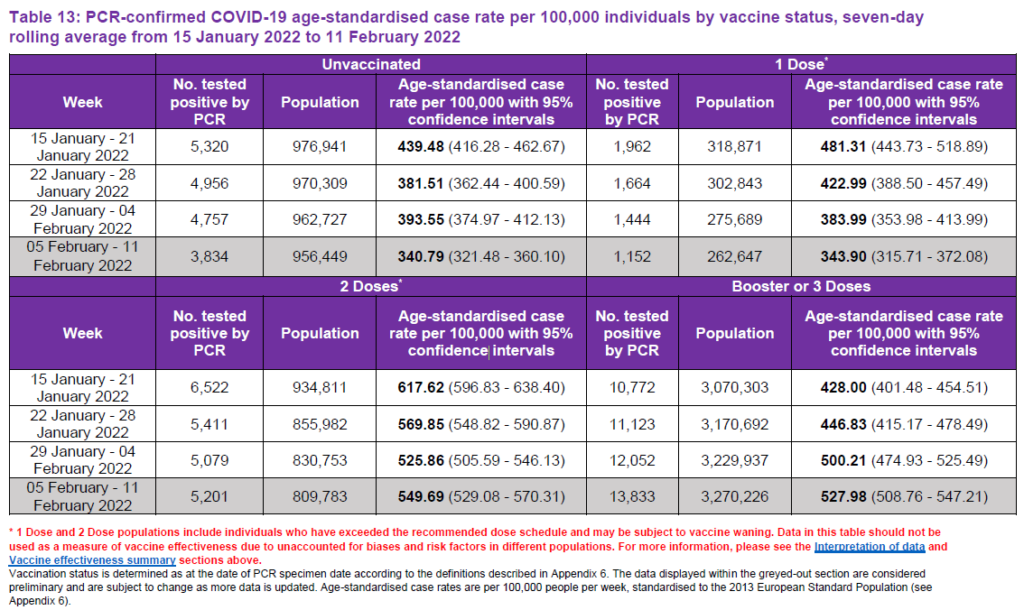

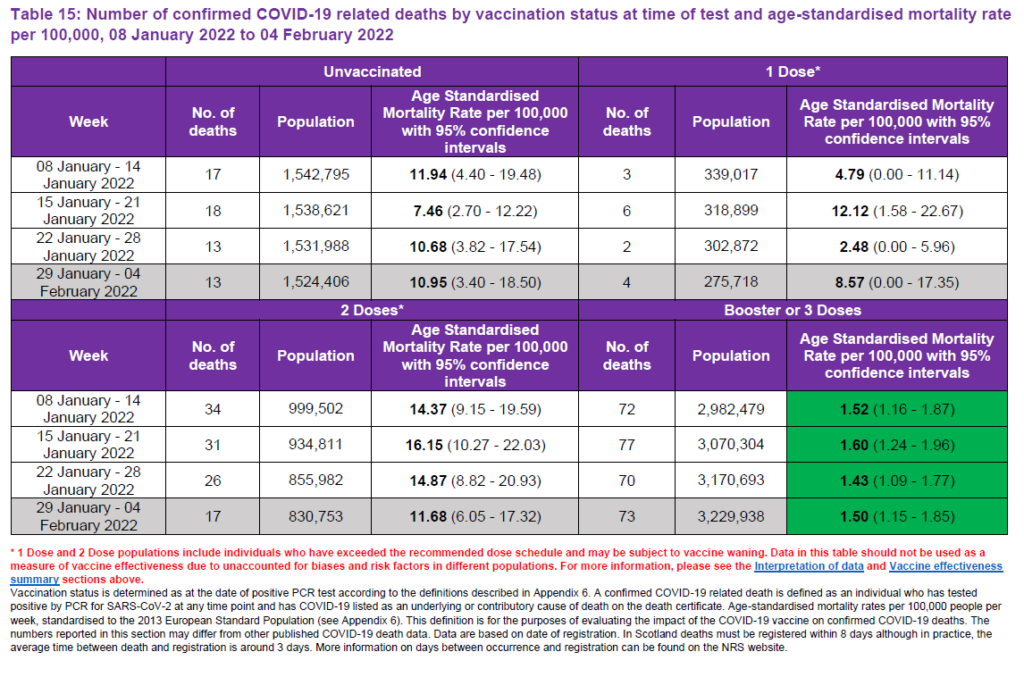
Here are graphs showing unadjusted vaccine effectiveness (actually, it is adjusted for age, but it’s not adjusted for anything else, such as testing behaviour, comorbidities or prior infection). The data seem a bit noisy, but the sharp decline in the three-dose and two-dose effectiveness this week may lie behind the decision to stop publishing them.
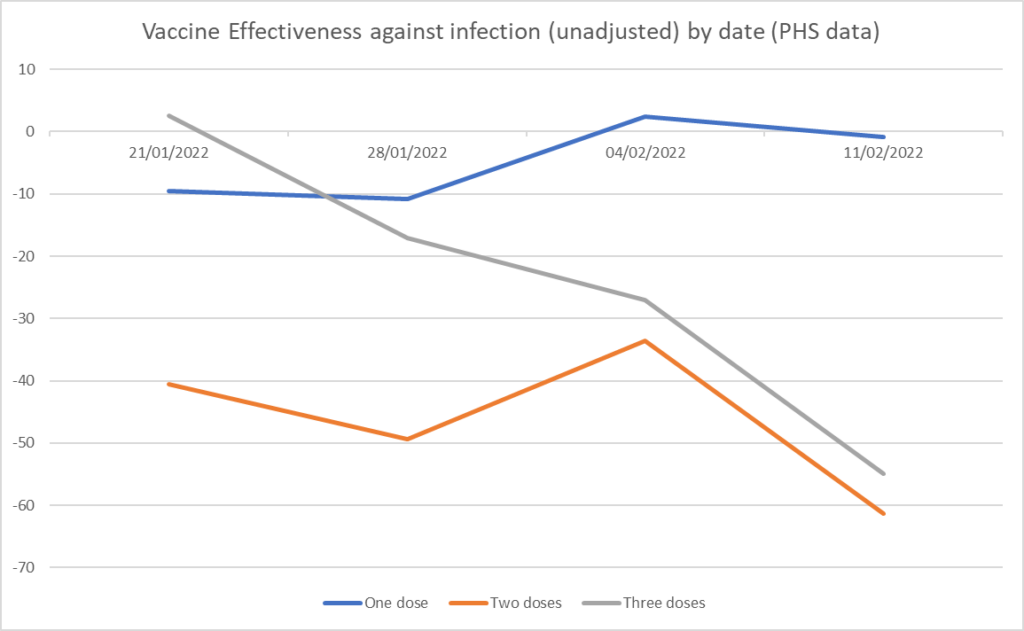
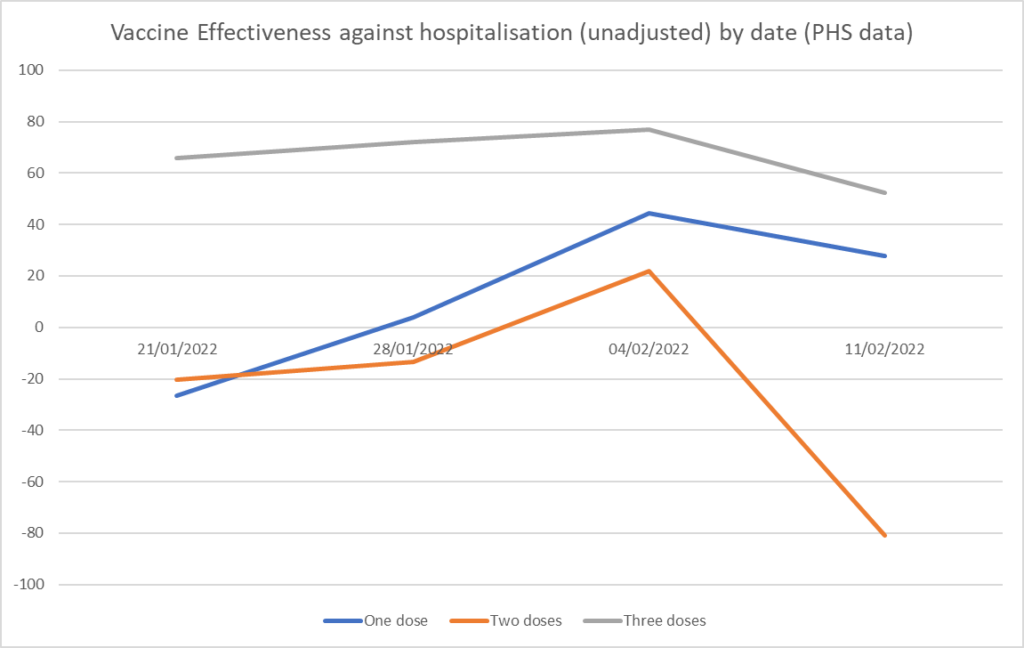
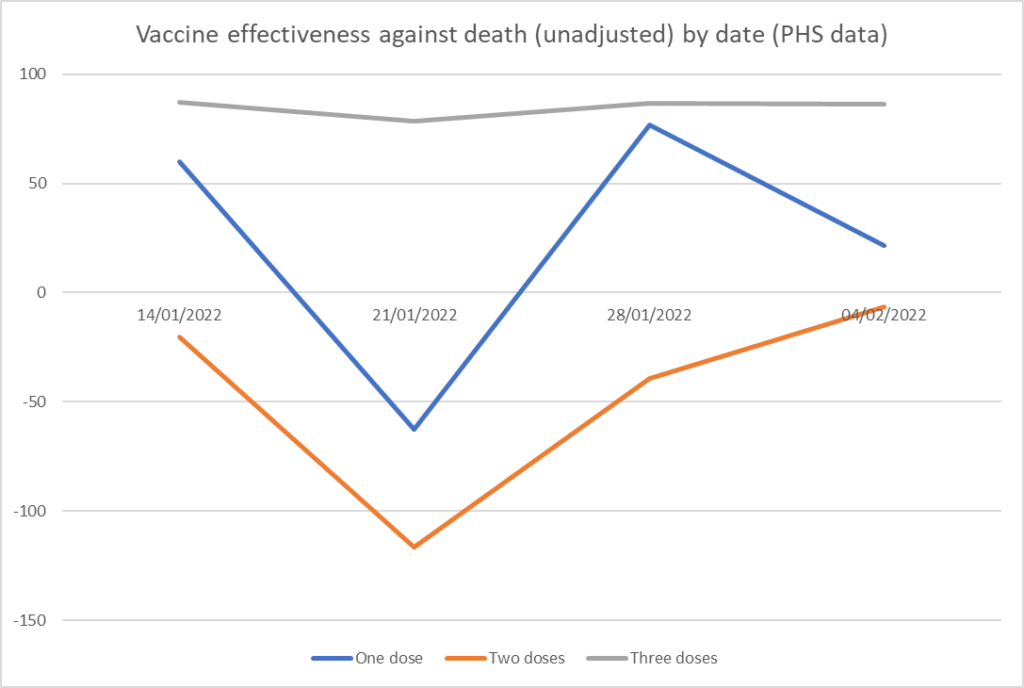
Here are the absolute proportions of cases, hospitalisations and deaths by vaccination status, courtesy of the Freedom Podcast, showing it is most definitely not an epidemic of the unvaccinated.
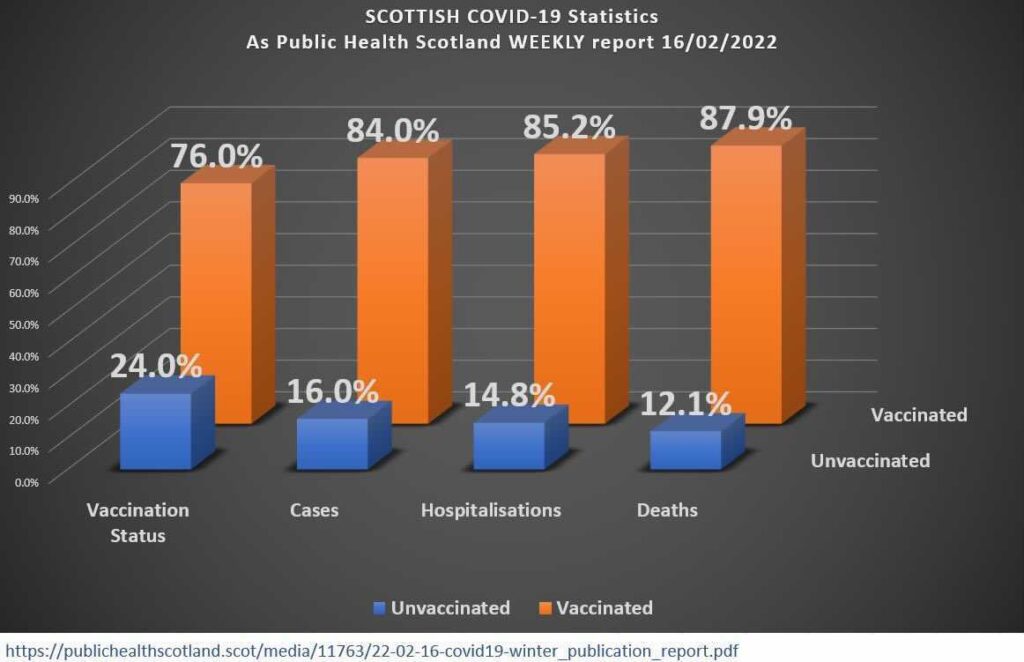
Stop Press: Read Eugyppius’s Substack post on this.












To join in with the discussion please make a donation to The Daily Sceptic.
Profanity and abuse will be removed and may lead to a permanent ban.
But surely the data will have to be given in response to FOI requests? Yeah right…
Wonder what excuses they will come up with?
I see the downticker is busy today!
Getting ready for a weekend off duty?
The information may be made available in a very redacted way…
When I was a kid I was told to envy the Scots for their superior educaton system. Frankly this woman seems mildly retarded. Hopefully the Scots will come to their senses.
Don’t hold your breath.
I’m a product of that education system and I credit my lifelong scepticism to my O Grade Modern Studies teacher who taught me to politely but tenaciously question everything I read in the media, especially from figures of authority.
I very much doubt there are any teachers like him in Scotland today.
My modern studies teacher was a Methodist lay preacher and sent me to the Headmaster for my obstructive questioning. The Head just told me to tone it down a bit.
All the sense, courage and intelligence in Scotland would fit into a teaspoon with plenty of room to spare.
More than 50% of the population with sense, courage and intelligence voted to remain in the Union in 2014.
Sadly, the FPTP system is as distorted up there as it is down here when it comes to elections, that’s why they canny get shot o’ the wee coo.
Not true. The majority of Scots that I’ve met could hold their own in any company. (They had emigrated south, however.)
Only mildly??!!
Public Health Scotland has announced that it is no longer going to publish its Covid infection, hospitalisation and death rates by vaccination status.
How is it Public now? They are killing people and have to hide it for their bosses at Big Pharma and the City of London.
…
No happy bunnies escape from this. You went along with it for very bad reasons and if you knew the price you will pay in blood then perhaps you would’ve been dissuaded. But maybe the siren song of money and power was just too much for you. This is the time the great revealing. There will be no hiding it under the mattress.
First, you cut the doors of classrooms in half and then hide inconvenient factual data.
Is the Scottish government insane or is it the population for enabling it to happen?
Are there any reports of doors that have been cut in half, or was it just a silly plan now abondoned after all the ridicule?
They’re still wondering how you hang half a door on a single hinge. (Nail it in place and then just duck under it?)
Those whom the gods wish to destroy they first make mad
Rather like the rest of the UK, the Scottish government hasn’t had much exposure to STEM subjects and is therefore flapping in the wind over anything technical.
Just when I think I’ve seen it all in this crisis and nothing will surprise me, something like this comes along.
Outrageous doesn’t begin to describe it.
These people are absolute scum.
Perhaps they really have gone mad? They don’t even bother to pretend to comply with what used to be regarded as democratic “norms”.
Conventions, norms, civilised behaviour, and procedures of the kind that at least gave people some sense of understanding the way their societies operate, have been overthrown.
I keep telling friends who are very wary of anything that sounds like a “conspiracy theory” but remarkably complacent when confronted by appalling behaviour on a grand scale, that we are not on the way to totalitarianism – we’re in it (certainly in Australia, and in Scotland, Wales, Austria, Germany, France, Italy, New Zealand, Canada et al).
We are ruled by tyrants, who will become more and more deranged by the power they wield.
Yes, I’ve just watched an unrelated video advocating for safetyism in order to prevent suicides, which makes me lean toward the theory that many people have truly gone insane and do not realize what they are advocating. They are not doing it out of cynical spite, they truly believe it will help and they are morally justified. The question is how do we even approach treating this severe mental condition, which seems to be spreading like wildfire, given that the inmates are running the asylum,
Safetyism in what way? Not sure how ever-more rules and regulations could be expected (even by politicians) to make any difference!
We can be damn sure that if the data suggested the opposite, they would not be quite so coy.
Villains, pure and simple.
You shouldn’t be suprised, the whole covid scare has been based on models rather than data. If politicians had paid attention to real world data they would’ve realised straight after the Diamond Princess that covid wasn’t anywhere near as bad as the models were suggesting.
This is just another example of the similarity between the covid scare and the climate change scare. Produce models to show what you want them to show, or at the very least trust highly dubious models and if real world data disproves or contradicts the models ignore and supress it and keep claiming that the models are somehow better than the facts.
Hilarious! ‘the actual data are so poor, we will report the modeling instead’!
The actual data is so poor that we based our decisions on it until it proved our point.
Fandabidozi!
Scam dabby dozy!
We have to make something out of this. Even if it is just impoverished localism and jumble sales. Who cares about all the corporate crap when you have a sense of belonging with your neighbours.
Oh dear – what a tacit confession. How low can all this sink. Into the abyss obviously. These people are not going to have a lot of fun when they spend eternity in hell. Mind Daily Sceptic ruffling SNP feathers. Who would have thought it. Feather in Toby’s hat.
A more apt picture for the header…? She seems to like his way of doing things….
The idea of allowing people to make decisions based on data collected by people they pay to collect it!
We interpret – you misinterpret.
The data is “modelled” to avoid having to stand in front of a wall Ceausescu style.
He took a dive!
More problems in Canada
Is Canada facing a Bank Run? | ZeroHedge
“Is there a bank run going on in Canada, or is the banking system failing – or is this the beginning of the “Great Reset” ? Or, have government sponsored activists hacked the banks in order to prevent Truckers from accessing any funds? We don’t know, but people are reporting withdrawal trouble, and many banks are offline:”
The law of Tru-doh! unintended consequences.
If the Canadian banking system collapsed, and even caused another 2008 event, no doubt it would all be blamed on a few thousand truckers.
Tru-doh seems to have the mental capacity of Play Doh
That is very worrying. What next I wonder
Talking of missing data….
I’ve conducted a study into this and it’s none. Currently assessing traffic light entry systems and will release a preprint shortly.
You would have thought they would have gotten a clue from one way supermarket car parks, which are universally ignored.
Remember to distinguish between those where people can just ignore them, and those where the lights are interlocked with the door so it’s impossible to enter when the light is red as the door won’t open (co-op in a local village had this ridiculous system)
Of course, that’s so we could avoid the indians – a.k.a. native americans for those with a nervous disposition
The two basic arguments against publishing this are
Regarding the first: Considering the massive travel and general Corona restrictions, it seems very unlikely that so many Scots have emigrated since 2020 to make the registration number wildly inaccurate. It’s also not really known whether or not this has actually happened. PHS speculates that it did probably happen. But the opposite could as well be the case: The number is actually too low because of people who never registered with a GP.
The second is just asserted, despite no one can conceivably know this.
Pulling this together, this means PHS doesn’t want to publish this data anymore and uses some ready-made BS whose factual basis cannot possibly be checked as pseudo-justification for that.
Should obviously have been without deregistering.
The very notion of a graph or chart is suspect according to the secret teaching because it represents the expression of Ahrimanic forces in our time. We need to understand Ahriman, the tyranny of numbers and calculation, and then move beyond. As the English this is our mission there is no other way. This is the highest of spiritual and intellectual missions.
Erm…come again.
I thunk it’s something to do with Mithraism, which is a load of Bull.
Thanks Annie. I’m still none the wiser and can’t be bothered to look these up.
Gonna get a bit windy tonight.
earth :: a global map of wind, weather, and ocean conditions (nullschool.net)
Good luck.
Great site, seems water has a lot more to do with climate than plantfood.
The SNP don’t do facts, and that is a fact!
Toby how dare you.
Wait till I just lift my jaw up from the floor..
The case rates, hospitalisation rates, the death rates are very simple statistics, whereas for the vaccine effectiveness studies we use modelling, we compare people who have tested negative to those who have tested positive and match them on their underlining co-morbidities. It’s a completely different method which is much more robust and that’s what we want people to focus on.”
So actual figures are not robust?
I suppose not, if you treat them on the basis that two and two make one vaccinated or five unvaccinated.
Models are far better as it’s much easier to tweak the methodology to give the required result!
Not that politicians and their lackeys would do that sort of thing, of course…
Public Helath Scotland continue to encourage pregnant women to ‘get the jab’:
https://www.publichealthscotland.scot/news/2022/january/scottish-study-leads-to-calls-for-more-pregnant-women-to-get-fully-vaccinated/
Austrian midwives publish an open letter to their Government:
‘We are also very concerned about observations related to the timing of Covid-19 vaccination in pregnant women, which are often not followed up: Miscarriages, preterm labor, early preterm rupture of membranes, vaginal bleeding, preterm birth, growth retardation, eclampsia, myocarditis, etc.’
https://www.wochenblick.at/allgemein/koennen-das-nicht-laenger-hinnehmen-217-hebammen-sind-laut-gegen-gen-spritzen/
I have wondered for some time why they have continued to give us all the ammo we need to destroy their claims.
It points to a less than perfect conspiracy. In other words people down the chain are acting in good faith under political circumstances they aren’t party to. If the vaccines were so necessary, safe and effective, why wouldn’t you want to publish the data?
Thought some compartmentalised and politically naive middle manager near the start of this embarrassing campaign.
Because they’re idiots. They didn’t realize what the numbers were indicating until one of them saw it on social media.
This course of action is an absolute gift. It allows any commentator to wind up an article / discussion / argument with something like this:
It is not possible to draw any firm conclusions as to current covid mortality figures, nor to be able to support the current vaccination campaign as PHS are continuing to refuse to release the numbers confirming hospitalisations and deaths for both vaccinated and none vaccinated.
However, on the balance of probabilities outcomes for the vaccinated are worse than for none vaccinated.
You can’t argue with that
To those in the mainstream media slandering The Daily Sceptic, the difference between the content here and your content is that here, we are treated to an honest analysis of the data, with all its complexities and potential biases, and genuinely curious questioning from real journalists without a narrative to push. Most importantly, we are treated as adults capable of making our own minds up about what is presented to us.
Your content, on the contrary, doesn’t bother to analyse or question anything. It merely asserts a narrative and expects us to accept it all without question as if we were children. Why would we? What is it exactly you are providing of any value? No wonder readers are abandoning you. Finally, stop calling yourselves “journalists.” Nobody is buying it anymore and you’re not fooling anyone.
Well said.
Hear! Hear! The “watchdog journalist” is now basically extinct.
It’s like they’re doing everything they can to reinforce the anti-vaxxers’ case.
Why would they do that?
And what is an “anti-vaxxer” exactly?
Antivaxxer:
noun informal.
a person who knows the COVID-19 gene therapies don’t protect against any viruses; a person that will not take the COVID-19 gene therapies due to them not being actual vaccines; a person who believes they were given autonomy over their own bodies by God and not by other humans
And they would have got away with it if it wasn’t for those meddling anti-vaxxers!
These people might well have a lot of illegal activity to hide. It’s been claimed that one of the experiments associated with the gene therapies was/is to test a drug delivery vehicle that can cross the blood–brain barrier (BBB).
A quote from ScienceDirect:
If people wonder about psychiatric drugs being able to cross the BBB, they don’t actually cross this barrier. Psychiatric drugs work on the brain in a similar way to alcohol, they just numb parts of the brain which makes the mentally ill patients more docile. These drugs don’t permanently alter the brain.
What Neuropharmaceutics is all about is being able to permanently alter the human brain with drugs and nanotechnology. As we’ve seen with the gene therapies, they can already reprogram human cells to produce spike proteins from a computer-generated blueprint.
If Big Pharma ever manages to develop a drug delivery system that can carry pharmaceuticals and nanotechnology across the BBB, they will then be able to reprogram brain cells to make people think and behave as the Cabal requires.
I don’t think Nicola Sturgeon need worry about this. I suspect if you crossed her BBB, you’d find brain cells that are too reptilian and sclerotic to be altered in any meaningful way.
No need to be rude about reptiles!!
I’ve seen all I need to see from hereon in. I’ll never take a vaccine again in my life. My faith in health officials has gone the same way as it did for politicians after Iraq and the media after Brexit.
I care not for their bullshit and my position is that everything that comes from these people is complete lies, fabrication and propaganda. No need to listen to any of them, pass the ear defenders!
The sad unintended consequence of all this government manipulation is that many people will stop wanting to use any new vaccines or even the old ones. How can we trust or respect our GPs most of whom have been led by the nose throughout. I now regard mine as a rather silly woman who was so proud of being jabbed with Pfizer because she is German. Initially early in 2020 she said to me that there would be no vaccine for ten years for safety reasons and so we were all doomed. A few months later she was singing praises of “the vaccine” to the stars without question.
My mum is also German and anything but happy that she’s now supposed to have a fourth COVID jab she has to take to avoid being excluded from society. At 83, mind you. Corona’s witnesses are well beyond being a disgrace now. They’re becoming positively non-human in their desire to repeat-perforate everyone who doesn’t run away quickly enough for the sake of doing so.
‘a rather silly woman who was so proud of being jabbed with Pfizer because she is German.’
It hasn’t been the medical profession’s finest hour has it?
She’s thick.
Only use your GP to obtain prescription only stuff, but read about non prescription alternatives.
And not just the idea of using vaccination for anything else, but a general loss of confidence in the trade.
You just know that the data is now so bad that they can no longer hide it or obfuscate it.
….
This is priceless. Our own data is disproving all of our claims and so we will no longer publish this data.
Sturgeon is so lame, she probably is genuinely getting the vaccine in that photo.
It’s not like she has to worry about fertility……..
Here is blatant proof that these people are serving themselves, not the public. They are not alone, of course: the same can be said, to a greater or lesser extent, about many other public “services”. The covid fiasco has exposed self-serving cultures in health, policing, the civil service, local government, central government, and the spavined opposition.
The culture is so deeply entrenched that I can’t see how it can be changed without scrapping the institutions and starting again. But who the hell is able to do that?
@Will @Toby
Your move. They are letting you know who’s boss
So true …
Everything is modelled. The ONS numbers have been modelled for months. Every economic statistic is modelled. Every ‘climate’ statistic is modelled.
We live in a virtual world, there is hardly anything that really relates to firm actual outcomes any more. Almost everything we read, watch, listen to is manipulated.
Sport is corrupted by drugs, political manipulation and of cause money.
Soon our individual finances will be determined by Central Bank virtual currencies, able to be turned on and off by third parties. Our bodies are no longer our own, our sex is indeterminate. Our language is subject to instant change and manipulation. Our ethics and morals are not the ones we believed there were.
All we have is what the hive masters tell us we have.
Unless enough of us say, NO!
In short, the Scottish authorities are saying we’ve all got to believe what they’re saying without knowing their supposed reasons, because if we knew their supposed reasons they’d lay themselves open to criticism, and the kind of people who would dare criticise them are bad, bad, bad. Only liars talk like that. All who are reading this and who have a vote in Scotland, please use it so as to maximise the probability of the SNP losing seats and losing office. Please make that your top priority in the polling booth. If you have to wear a clothespeg, wear one. Just help bring down this gang of corrupt lying thieves.
I’ve said for a long time now that my strong belief is that what is happening in other parts of the once civilised world are trials for what will be implemented as a whole on all of us.
When we see Scotland openly censoring public information, we should know they’re testing. When we see gulags in Australia, we should know they’re a test for all of us. Canada, calling peaceful protestors “terrorists”, America jabbing children, etc. We know it’s coming our way.
We’re told they’re phasing this stuff out – no they’re not. The new human rights laws they’re planning to introduce in April will effectively make the coronavirus act redundant. The new human rights laws are a tyrant’s wet dream.
They’re planning something big around April, by which point the deliberate financial crisis will have really started to destroy lives.
Wlhy isn’t the mass media screaming in protest at this clear official attempt to spread misinformation by omission?
Rhetorical question, obviously.
It was always going to happen. Marxist Scotland was always going to stop publishing data to the contrary of their cause. Soviet Russia did the same.
Expect every country to follow suit.
This only disproves the official narrative
I’m Scottish. I live in Scotland. I’m appalled by this. I’m appalled by just about everything the Scottish Government does. I totally dislike Nicola Sturgeon. It just gets worse and worse. Duplicitous doesn’t cover it…
I’m Scottish. I live in England. I feel the same way you do. If I lived in outer Mongolia I would feel the same way.
In 2020, when Jean Freeman was Health Secretary or whatever monitor’s badge she wore, wanted to keep all information about Covid from the public and now it has come to pass. We’ll be inundated with restrictions courtesy of whatever panels of ‘experts’ are chosen to come up with whatever results are necessary to keep us under the thumbs of these despicable SNP and Greens. I despair, I truly despair. I wish the Scottish Government were suspended – in all senses of the word.
So the SNP have decided to abandon their previous ‘lies, damned lies and statistics’ approach in favour of giving out information that cannot be challenged? Those who voted in this bunch of incompetents as their government must be delighted with the second Scottish enlightenment
The ones that voted for her are delighted. They just can’t get enough of tyranny.
I spent my 3 years university education in Aberdeen, back in the late 60s. As I knew the scottish population back then they had a strong sense of right vs wrong and they were nobody’s fools. When did it change?
“…as the COVID-19 pandemic enters its second year”
It is actually entering its third year. Maths doesn’t seem to be their strong point.
tl;dr summary of their position: “We have unknowable numbers and unprovable assumptions that result in unpalatable results. We will therefore replace those with different unknowable numbers and unprovable assumptions until the results support our policies.”
I don’t think that’s an unfair characterisation.
It’s the political equivalent of ‘taking the Fifth’.
You can’t be forced to reveal results that will show your utter failure and pomposity.
Nice placebo, Nicola! Look me in the eyes and tell me you’ve had the vaxx…
Cowardly and despotic actions of an out-of-touch regime!
Presumably the ZOE app will be knobled in some way to stop the data getting out that way as well?
If i was that person administering the vaccine to Krankie, I’d ram it so far up her arse that she wouldn’t be able to talk for a week. Everyone’s a winner then.